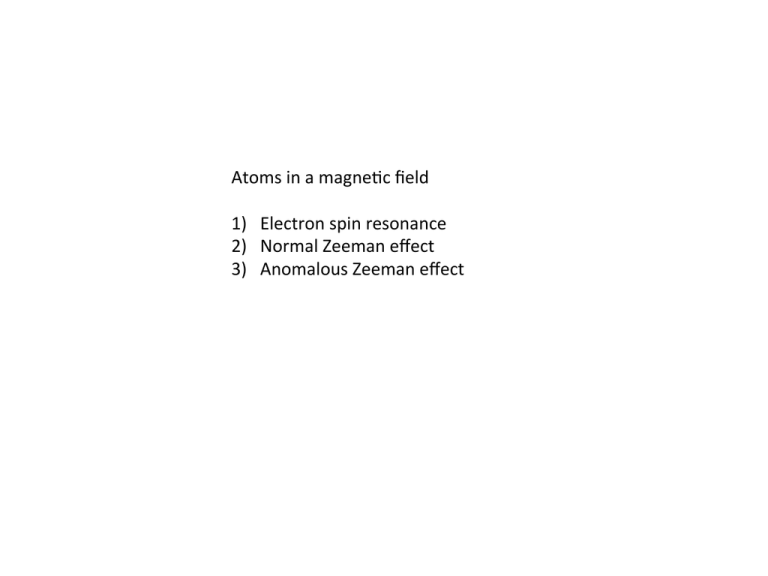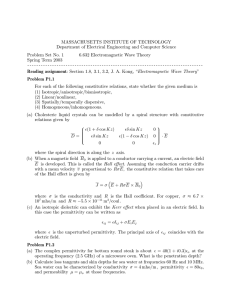Atoms in a magne:c field 1) Electron spin resonance 2) Normal
advertisement

Atoms in a magne,c field 1) Electron spin resonance 2) Normal Zeeman effect 3) Anomalous Zeeman effect We have already seen that a direc&onal quan&za&on exists (Stern-­‐Gerlach): The angular momentum vectors in an atom can only orient themselves in certain discrete direc&ons rela,ve to a par,cular axis (the quan,za,on axis). The direc,onal quan,za,on is described by the magne,c quantum number m. In an applied magne,c field B0, the interac,on energy between the field and the magne,c moment of the electrons in an atom, which we have already calculated, leads to a spliOng of the energy terms, which is described by the different possible values of the magne,c quantum number. A first applica,on of the spliOng of atomic states in a magne,c field to the determina,on of the magne,c moments of the atoms was already discussed in the treatment of the Stern-­‐ Gerlach experiment. In the following, we shall consider some other types of experiments. Electron Spin Resonance The method of electron spin resonance (abbreviated ESR, some,mes EPR for electron paramagne,c resonance) involves the produc,on of transi,ons between energy states of the electrons which are characterized by different values of the magne,c quantum number m. In general, the degeneracy is liRed by the applica,on of an external magne,c field; the transi,on frequencies, which are usually in the range of microwave frequencies, depend on the strength of the applied field. With this technique, one can observe transi,ons between states of different magne,c quantum number directly. Electron Spin Resonance The principle of ESR may be easily understood by considering the magne,c moment produced by the spin of a free electron in a magne,c field B0 An electron has the magne,c moment with the possible components along the quan,za,on axis z of the field B0 The poten,al energy of these two orienta,ons differs by the amount Electron Spin Resonance If a sinusoidally varying magne,c field B1 = B1 sinωt is now applied in a direc,on perpendicular to B0, transi,ons between the two states are induced if the frequency ν = ω/2π fulfills the condi,on The transi,ons with Δm = ± 1 are allowed magne,c dipole transi,on The frequency which must be used depends on the choice of the applied magne,c field B0. For reasons of sensi,vity, usually the highest possible frequencies are used, corresponding to the highest possible magne,c fields. The fields and frequencies used in prac,ce are, of course, limited by ques,ons of technical feasibility; usually, fields in the range 0.1 to 1 T are chosen (T = Tesla). This leads to frequencies in the GHz region (cm waves). Electron Spin Resonance The fundamental idea of ESR may be illustrated by a mechanical model: a gyroscope containing a bar magnet in its axis is precessing in a magne,c field. The precession frequency is (neglec,ng gravita,onal force) When we now let an addi,onal oscilla,ng field B1 with the frequency ω act perpendicular to B0, we observe a con,nuous increase or decrease in the angle of inclina,on α, depending on whether the field is in phase or out of phase with the mo,on of the gyroscope, provided that the frequency ω is equal to ωL. Electron Spin Resonance This model may be immediately transferred to the atom. We replace the magne,c moment of the bar magnet by the moment of the atom and obtain for the circular frequency of the electron spin resonance the following condi,on: This is the Larmor frequency In the classical gyroscope model, the ,p of the gyroscope axle moves on a spiral orbit from one stable posi&on to another. This picture may be applied with considerable accuracy to the mo,on of the spin or the orbital angular momentum in an atom. There is an addi,onal possibility for picturing the resonant transi,ons, which makes use of the fact that the spin or the angular momentum of an atom has only certain discrete allowed sta,onary orienta,ons in a constant magne,c field B0. In this picture, the spin makes transi&ons between these discrete energy levels under the influence of the oscilla,ng field B1, In par,cular, this means in the case of spin 1/2 that the spin flips from the one possible orienta,on to the other when the resonance condi,on is fulfilled. Electron Spin Resonance Schema,c representa,on of the experimental setup. The sample is located in a resonant cavity between the pole pieces of an electromagnet. The microwaves are generated by a klystron and detected by a diode. To increase the sensi,vity of detec,on, the field B0 is modulated. Below, leE: Energy states of a free electron as func,ons of the applied magne,c field. Below, right: Signal U from the diode as a func,on of B0 for resonance Electron Spin Resonance If you were always dealing with systems with a single spin, then ESR would always consist of just one line, and would have lible value as an inves,ga,ve tool, but several factors influence the effec,ve value of g in different seOngs. Much of the informa,on obtainable from ESR comes from the spliOngs caused by interac,ons with nuclear spins in the vicinity of the unpaired spin, spliOngs called nuclear hyperfine structure. The Zeeman Effect The spliOng of the energy terms of atoms in a magne,c field can also be observed as a spliOng of the frequencies of transi,ons in the op,cal spectra (or as a shiR). A spliOng of this type of spectral lines in a magne,c field was observed for the first ,me in 1896 A flame coloured with sodium or NaCl appears dark when projected using light from a Na vapour lamp. Upon switching on a magne,c field, it brightens, since the resonance between the light from the lamp and the light of the sodium flame is destroyed by the Zeeman effect. The wavelength of the light from the flame is shiRed slightly by the magne,c field; this suffices to remove the resonance The Zeeman Effect Transverse and longitudinal observa,on of spectral lines in a magne,c field. The three component electrons used in the classical descrip,on of the Zeeman effect are indicated (orbits with arrows in the pole gap of the magnet). The emission of a light source in the magne,c field is observed either transversely or longitudinally (through a hole drilled in the magnet pole piece). S is the entrance slit of a spectrometer The Zeeman Effect With a Fabry-­‐Perot interferometer or with a gra,ng spectrometer of sufficient resolu,on, the spliOng in magne,c fields may be quan,ta,vely measured. The spliOng behaviour observed in moderate magne,c fields is illustrated: Ordinary Zeeman effect, e.g. for the atomic Cd line at λ = 6438 Å. With transverse observa,on the original line and two symmetrically shiRed components are seen. Under longitudinal observa,on, only the split components are seen. The polarisa,on (E vector) is indicated. Anomalous Zeeman effect, here using the sodium D lines. The D1 line splits into four components, the D2 line into six in a magne,c field. The wavelengths of the D1 and D2 lines are 5896 Å and 5889 Å; the quantum energy increases to the right in the diagram Both the ordinary and the anomalous Zeeman effects merge to the so-­‐called Paschen-­‐Back effect in sufficiently large magne,c fields B0, We shall now discuss these three effects of the influence of magne,c fields on the spectral lines and the energy terms of atoms The Zeeman effect may be understood to a large extent using classical electron theory, as was shown by Lorentz shortly aRer its discovery. We shall restrict ourselves to the ordinary Zeeman effect -­‐ the spliOng of states with pure orbital angular momentum. If the resultant angular momentum is composed of both spin and orbital contribu,ons, one speaks of the anomalous Zeeman effect. The normal Zeeman effect describes states in which no spin magne,sm occurs. In these states, at least two electrons contribute in such a way that their spins are coupled to zero. We discuss the emission of light by an electron whose mo,on about the nucleus is interpreted as an oscilla,on, for example by considering the projec,on of the mo,on on a certain direc,on. We ask the ques,on, "What force does a magne,c field exert on a radia,ng electron?" The radia,ng electron is treated as a linear oscillator with a random orienta,on with respect to the magne,c lines of force In the model, we replace the electron by three component oscillators according to the rules of vector addi,on: component oscillator 1 oscillates linearly, parallel to the direc,on of ^o-­‐ Oscillators 2 and 3 oscillate circularly in opposite senses and in a plane perpendicular to the direc,on of B0. This resolu,on into components is allowed, since any linear oscilla,on may be represented by the addi,on of two counterrota,ng circular ones. Without the field B0, the frequency of all the component oscillators is equal to that of the original electron, namely ω0 1) Component 1, parallel to B0, experiences no force. Its frequency remains unchanged; it emits light which is linearly polarised with its E vector parallel to the vector B0 2) The circularly oscilla,ng components 2 and 3 are accelerated or slowed down by the effect of magne,c induc,on on turning on the field B0, depending on their direc,ons of mo,on. Their circular frequencies are increased or decreased by an amount Classically, one can calculate the frequency shiR δω for the component oscillators as follows: without the applied magne,c field, the circular frequency of the component electrons is ω0. The Coulomb force and the centrifugal force are in balance, i.e In a homogeneous magne,c field BQapplied in the z direc,on, the Lorentz force acts in addi,on; in Cartesian coordinates, the following equa,ons of mo,on are then valid: From (c), we immediately find the solu,on for component oscillator 1, i.e. the frequency of the electron which is oscilla,ng in the z direc,on remains unchanged. To solve (a) and (b), we subs,tute u = x+iy and v=x-­‐iy. It is easy to show that the equa,ons have the following solu,ons (with the condi,on eB0/2m<<ω0): These are the equa,ons of mo,on for a leR-­‐hand and a right-­‐hand circular mo,on with the frequencies ω0±δω with δω= eB0/2m. The component electron oscillators 2 and 3 thus emit or absorb circularly polarised light with the frequency ω0±δω The spliOng observed in the ordinary Zeeman effect is therefore correctly predicted in a classical model. The frequency change has the magnitude: For a magne,c field strength B0=1T this yields the value: Independently of the frequency ν, we obtain the same frequency shiR δν for each spectral line with a given magne,c field B0. Theory and experiment agree completely here. Descrip<on of the Ordinary Zeeman Effect by the Vector Model we now take the first step towards a quantum mechanical descrip,on. The angular momentum vector j and the magne,c moment μJ, which is coupled to j, precess together around the field axis B0. The addi,onal energy of the atom due to the magne,c field is then The (2j+1)-­‐fold direc,onal degeneracy is thus liRed, and the term is split into 2j+1 components. These are energe,cally equidistant. The distance between two components with Δmj = 1 is Descrip<on of the Ordinary Zeeman Effect by the Vector Model SpliOng of the λ = 6438 Å line of the neutral Cd atom, transi,on 1P -­‐1D , into three components. 1 2 The transi,ons with Δmj = 0 are called π transi,ons; those with Δmj= ±1 are σ transi,ons. The quantum number J is wriben as a capital leber because the atom has several electrons. Here, S = 0, and J=L: we are dealing with a case of purely orbital magne,sm The Normal Zeeman Effect (when S = 0) The Anomalous Zeeman Effect (when S ≠ 0) One speaks of the anomalous Zeeman effect when the angular momentum and magne,c moment of the two terms between which an op,cal transi,on occurs cannot be described by just one of the two quantum numbers s or l (or S or L), but are determined by both. This is the general case, in which atomic magne,sm is due to the superposi,on of spin and orbital magne,sm. The term "anomalous" Zeeman effect is historical, and is actually contradictory, because this is the normal case. In cases of the anomalous Zeeman effect, the two terms involved in the op<cal transi<on have different g factors, because the rela,ve contribu,ons of spin and orbital magne,sm to the two states are different. The g factors are determined by the total angular momentum j and are therefore called gj factors. The spliOng of the terms in the ground and excited states is therefore different, in contrast to the situa,on in the normal Zeeman effect. The Anomalous Zeeman Effect We will use the Na D lines as an example for a discussion of the anomalous Zeeman effect. For the three terms involved in the transi,ons which produce the Na D line, namely the 2S1/2, the 2P1/2 and the 2P3/2, the magne,c moments in the direc,on of the field are The number of spliOng components in the field is given by mj and is again 2j +1. The distance between the components with different values of mj -­‐ the so-­‐called Zeeman components -­‐ is no longer the same for all terms, but depends on the quan-­‐ tum numbers l, s, and j: The Anomalous Zeeman Effect (when S ≠ 0) The Anomalous Zeeman Effect (when S ≠ 0)





